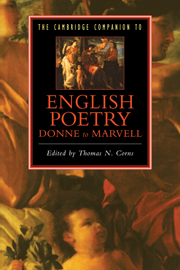3 - Manuscript, print, and the social history of the lyric
from Part 1 - The context
Published online by Cambridge University Press: 28 May 2006
Summary
In the English Renaissance, poetic texts were related to their social contexts both in their original conditions of production and in their subsequent history of reception through the media of manuscript and print. Since lyric poems, in particular, were primarily occasional, composed in specific circumstances for known audiences, factors of class, gender, patronage, kinship, friendship, political partisanship, and religious allegiance were inseparable from aesthetic issues in such works. Poets were acutely conscious of the social contexts of their work, and, especially when their poems were disseminated in manuscript, readers were able to appropriate poetic artefacts and adapt them to their individual needs. In the course of the seventeenth century lyrics were in the process of changing their status from that of ephemeral productions transmitted in manuscript within restricted social environments to that of durable artefacts widely distributed through the medium of print. While most lyric poetry first circulated in manuscript to family members, friends, colleagues, and patrons had specific social uses, print culture began to highlight the aesthetic features of poems, recontextualized their meanings, and preserved them for readerships beyond their original audiences.
- Type
- Chapter
- Information
- Publisher: Cambridge University PressPrint publication year: 1993
- 3
- Cited by



